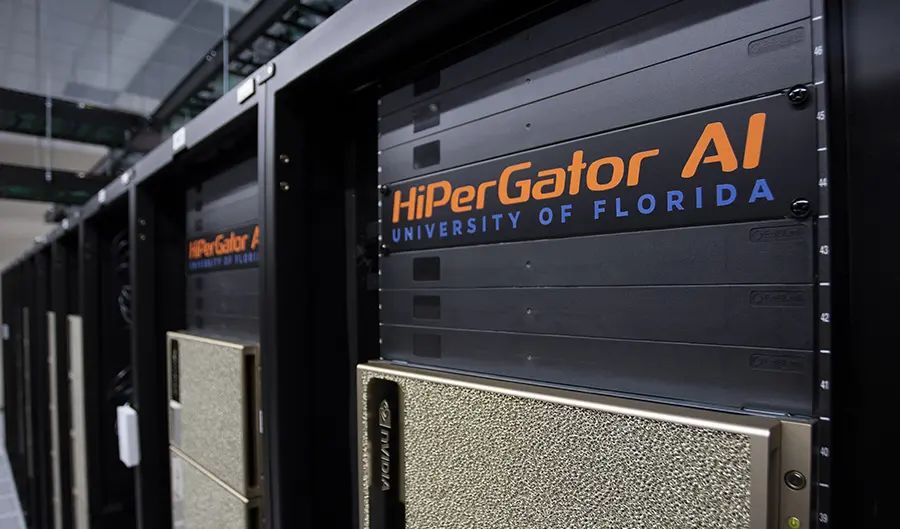Advancing AI Across the Curriculum
Lessons learned from a pioneer in AI integration

Advancing AI Across the Curriculum
Lessons learned from
a pioneer in AI integration

Universities are rethinking curriculum design, research and faculty support to integrate AI across disciplines—preparing students for an evolving workforce and an AI-driven future.
Universities are rethinking curriculum design, research and faculty support to integrate AI across disciplines—preparing students for an evolving workforce and an AI-driven future.
Artificial intelligence is reshaping every industry from engineering to the arts. For universities seeking to prepare students for their careers, the question isn’t whether to adapt—it’s how.
“Universities must engage with AI technology,” says Joseph Glover, interim provost of the University of Florida (UF) and a pioneer in advancing AI in higher education. “Students are going to look for AI at their university of choice, and if they can’t see it there, they’re going to vote with their feet and go somewhere else where they can get it.”
The core of the challenge is how universities can best integrate AI into classrooms and curricula to ensure that graduates are AI-literate and AI-competent, especially when technology is undergoing such rapid change.
Part of the answer is to encourage departments and colleges to adopt and grow AI organically for their own specific educational and research purposes, rather than mandating and prescribing its use from the top down, Glover says.
Scholars and students in various disciplines use different AI tools and approaches that align with their unique objectives, he says. For example, business professors may wish to employ AI for fintech education and applications, while those in agriculture may be more interested in using AI tools for classes or research into the use of remote sensing and robotics for harvesting.
Letting each discipline take the lead in AI integration not only guarantees their buy-in, but it also equips them to adapt as the technology evolves.
“The key is to welcome and encourage academic leaders and professors in embracing whatever form of AI works best for them and their students,” Glover says.
Expanding an existing AI-focused curriculum also relies on interdisciplinary collaboration, flexibility and student support.
Unlocking the Potential of AI
AI is multifaceted and complex, but implementation doesn’t require an expensive supercomputer. Universities can do a lot with relatively inexpensive computing resources.
Another avenue is to create research partnerships with universities that have their own supercomputer.
For example, institutions in the State University System of Florida can use UF’s supercomputer, HiPerGator. First gifted by UF alumnus and NVIDIA co-founder Chris Malachowsky in 2020, UF invested $24 million this year to purchase the newest version of the supercomputer, the most powerful in higher education currently. HiPerGator is also accessible to universities in the Southeastern Conference for teaching, and researchers throughout the US can access the supercomputer through partnerships with UF faculty.
Building Academic AI Pathways Across Disciplines
Expanding an existing AI-focused curriculum relies on interdisciplinary collaboration, flexibility and student support. Effective AI initiatives don’t live within a single subject area but encourage the exchange of expertise among fields as diverse as agriculture, astronomy, business and computer engineering.
With collaboration across disciplines, universities can:
- deepen the use of AI in existing courses
- facilitate open collaboration to test theories and strengthen practices
- build structured guidelines for ethical AI adoption
Holding recurring AI-centered showcases and events is another way for faculty and students to share projects and research efforts, discuss ethical concerns surrounding the use of AI and showcase emerging AI programs. AI-focused work groups or committees are also an effective way to continue the momentum.
Glover formed the UF AI BlueSky Visioning Taskforce in 2024, bringing together faculty, staff and students to chart the university’s path towards embracing AI over the next five years. The committee spent several months meeting with hundreds of internal and external stakeholders, distilling ideas and suggestions into seven overarching recommendations, which are highlighted in a report published in spring 2025. The university has since started implementing several of the recommendations, such as developing an AI personal assistant for students.

Joseph Glover, interim provost of the University of Florida
Joseph Glover, interim provost of the University of Florida
Offering Professional Development Opportunities for Faculty
Supporting faculty members is crucial when expanding AI offerings. As such, UF has created a resource, titled Building an AI University: An Administrator’s Guide, to offer structured guidance and direction when implementing and expanding AI use.
According to the guide, institutions can encourage faculty members to use AI for:
- Course preparation, including structuring lesson plans, aligning student learning objectives with materials and creating customized content
- Customized learning through prompts for activities, including self-quizzing and study guides
- Supporting students with different abilities, such non-native speakers who need assistance with language, course structure or access to alternative learning formats
Addressing challenges related to AI is a core component of the support institutions can offer. It is important for faculty members to be able to evaluate AI output, anticipate biases and outline clear policies for how students can use AI in their coursework.

Creating AI Pathways for Students
Expanding an AI curriculum also means emphasizing AI literacy. Institutions should ensure that students are more than just users of AI, empowering them to feel confident while using the technology. This can be done by:
- Introducing AI tools through low-stakes and non-graded assignments
- Raising awareness of privacy issues, ethics and bias in AI outputs
- Building course designations or tiered systems so students can better understand expectations for progression
- Partnering with career centers to create workforce-readiness workshops, with an emphasis on how AI will shape professions in the future
“Currently, we educators focus much of our attention on teaching AI skills, using AI for administrative tasks and, unfortunately, figuring out how to circumvent the labor-saving advantages of AI so we can cling to old teaching practices,” Glover says. “Our chief responsibility is much more fundamental. We need to help students strengthen their critical thinking, analytical and teamwork skills—all core human traits needed to participate in a democratic society and prosper in a dynamic economy.”
Taking the Next Step
Expanding an AI-based curriculum is a comprehensive process.
Interdisciplinary collaboration, a strong framework for faculty support and setting clear pathways for student success shape UF’s approach to AI integration, which continues to evolve. From course designation to campus-wide AI Days, UF demonstrates how investments in AI can prepare students and faculty for an AI-driven future.
“In my career as a professor and academic leader, I’ve seen the advent of scientific calculators, personal computers and the internet,” said Glover. “Although some feared that these developments would threaten education, it’s clear that they wound up strengthening it. AI is reshaping what goes on in the classroom, our curriculum and the public’s perception of the usefulness and relevance of higher education.”
Learn More about the University of Florida’s guidance for leveraging AI in higher education.
This custom content is sponsored by the University of Florida and developed by Inside Higher Ed's sponsored content team. The editorial staff of Inside Higher Ed had no role in its creation.
All photos credit: The University of Florida



